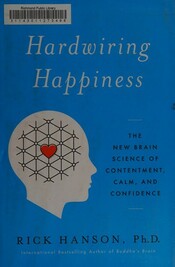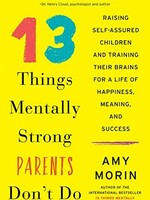
Hardwiring Happiness - Book Summary
The New Brain Science of Contentment, Calm, and Confidence
Release Date: April 30, 2024
Book Author: Rick Hanson
Categories: Psychology, Mindfulness & Happiness
Release Date: April 30, 2024
Book Author: Rick Hanson
Categories: Psychology, Mindfulness & Happiness
In this episode of 20 Minute Books, we explore "Hardwiring Happiness" by Rick Hanson. This enlightening book goes beyond typical self-help rhetoric by diving into the neuroscience of happiness. Rick Hanson, a bestselling author with a PhD in psychology, explains how to reprogram your brain to accentuate positive experiences and minimize negative ones.
"Hardwiring Happiness" is perfect for anyone who finds themselves often caught up in negative thinking, as well as optimists seeking more effective strategies for positive thinking. Students of neuroscience and biology will also find valuable insights into how the brain processes happiness. Join us as we uncover how simple shifts in focus can lead to lasting happiness, according to the latest research in brain science.
Understanding your negativity bias and how to counter it
Have you ever wondered why the evening news is filled with gloomy tales, seldom featuring uplifting stories? This phenomenon is rooted in our inherent negativity bias — a tendency to pay more attention to negative experiences than positive ones. This bias isn't just a modern media strategy; it’s wired into our brains, a survival mechanism from when our ancestors needed to be constantly alert to danger.
This narrative will guide you through recognizing this built-in bias that tilts your attention towards the negative, often overshadowing the joyful moments in life. More importantly, you'll discover practical strategies that can help turn the tide, training your mind to embrace positivity and happiness more readily.
You’ll explore:
- The reasons positive experiences rarely seem as impactful or memorable as negative ones;
- How our brains still react with the hyper-alertness of an ancestor evading predators;
- The power of savoring the simple pleasure of, say, chocolate, to elevate your spirits during a slump.
By understanding how your brain tends to dwell on the negative, you can actively influence it to soak up and retain the positive, rewiring your neural pathways for a happier, more optimistic outlook.
The brain's blueprint: sad vs. happy thoughts
Do you ever find yourself feeling like you just don't quite fit in, or maybe remembering those times you felt sidelined or teased during your school years? Whether you were the popular kid or not, you likely share some traits with those who felt rejected more easily.
Why is this? It's because negative experiences tend to evoke stronger, more lasting emotional responses than positive ones. Consider the last performance evaluation at work: filled with praise, yet it's that one minor critique that keeps replaying in your mind. This tendency to dwell on the negatives rather than the positives is a common human behavior.
Psychologist Roy Baumeister highlighted this in 2001 when he identified that people are naturally more attuned to angry faces than happy ones. This reaction to perceived negativity is an instinctive, subconscious response, alerting us to potential threats.
This propensity toward happy or sad thoughts can be traced back to a specific part of the brain — the amygdala, responsible for emotional reactions. Some individuals possess a "happy amygdala," which actively engages the nucleus accumbens, the brain's hub for goal pursuit. Those blessed with a happy amygdala are generally more optimistic, focusing on opportunities which spur actions towards achieving goals, perpetuating a cycle of positive experiences and reinforcements.
Conversely, many have a "sad amygdala," which contributes to fear-driven responses, releasing stress hormones like cortisol and adrenaline into our systems, leading to anxiety and apprehensiveness.
As we move forward, we will delve into understanding the "sad amygdala" more deeply and explore strategies that might just help turn those frowns upside down, fostering a happier, more resilient mindset.
How the brain evolves: adapting for joy or sorrow
Ever looked closely at a depiction of the human brain? It resembles a piece of lumpy, peculiar cauliflower stowed away in our skulls. But this odd-looking organ is a marvel of complexity, perpetually learning and changing.
The brain is not fixed; instead, it is dynamic, adapting and reshaping itself with every new knowledge and experience we encounter. Consider the fascinating 2000 study by neuroscientist Eleanor Maguire. She discovered that London taxi drivers, known for their remarkable ability to navigate the complex city streets, have a noticeably larger hippocampus – the brain area pivotal for memory and spatial orientation. This isn't due to any abnormality but rather, it signifies a well-exercised and developed part of their brain, much like a muscle that grows stronger with use.
This capacity of our brain to morph based on activities is key. It implies we can also train our brains to foster happiness. Psychologist Wil Cunningham's studies in 2013 revealed how environmental factors, like growing up without a nurturing, loving environment, could lead to developing what's termed a "sad amygdala."
Yet, there's good news: our brains can 'relearn' happiness. Therapeutic practices, such as those employed by psychologist Stanley Schachter, involve mental exercises where individuals visualize themselves in loving, supportive settings. These repeated mental scenarios can effectively rewire our brains, bolstering the neural pathways that trigger joy and diminishing those that activate sorrow.
This capacity to transform our brain architecture carries an inspiring message: we have the power to condition our minds towards positivity. But if that's the case, why do we still see widespread unhappiness in society? The answer might lie ahead, as we delve deeper into the mystery of our brain's adaptability.
How evolution fine-tuned our brains to stress over the little things
Remember being the last one picked for a soccer team during school recess? Your heart raced, stress hormones surged through your veins, and despite it being a simple game, it felt like a life-or-death scenario. This intense reaction isn’t just about sports or popularity—it traces back to our evolutionary need for survival.
Historically, human life was fraught with dangers, from conflicts with other humans to attacks by wild predators. This constant threat ensured that being attuned to danger was a crucial survival skill. To put it into perspective, it’s astonishing to note that during the World Wars, the likelihood of a soldier dying was significantly lower compared to the mortality rate of our prehistoric ancestors. During the wars, one in every hundred soldiers died, whereas in the perilous times of our hunter-gatherer forebears, one in every eight individuals met a violent death.
Fast forward to modern times, our brains still carry the imprints of that perilous past. They are wired to scan for and magnify potential threats, translating everyday stressors into severe threats to our well-being. A stern look, an unexpected loud sound, or even a fast-moving vehicle can trigger our ancient survival instincts.
Moreover, the relentless pressures of contemporary life—be it financial worries, job stress, or relationship issues—continually activate the same neural pathways that were originally designed to deal with life-threatening dangers. It’s as if our brains haven't quite realized that the saber-toothed tigers are long gone, and instead, they perceive modern-day challenges with the same level of urgency.
This evolutionary perspective reveals why our brains zoom in on every small modern stressor, making us feel perpetually on edge—as if we’re navigating a landscape filled with threats, rather than dealing with everyday challenges. This understanding not only highlights why we often focus on the negative but also underscores the importance of adapting our stress responses to fit our current environment rather than the ancient world we evolved from.
Overcoming the negativity bias for a more relaxed life
We've delved deep into why our brains tend to focus on the negative, a phenomenon so prevalent it's been given its own term: the negativity bias.
This bias isn't just a theory; it's observable in everyday scenarios, such as the structure of the evening news, which typically starts with the most shocking or distressing stories. This isn't merely a tactic to boost ratings; it reflects our innate fascination with danger and disaster.
The impact of this negativity bias goes beyond our media consumption — it directly influences our overall happiness and well-being. Negative events trigger our nervous system into high alert, causing our bodies to respond as if we ourselves are directly threatened. This reaction is part of the fight-or-flight response, releasing stress hormones like adrenaline and cortisol into our bodies, readying us to either confront or flee from danger.
Consequently, we often find ourselves reacting to daily irritants — whether a traffic jam or a work conflict — with disproportionate fear or aggression. From road rage to workplace arguments, the negativity bias can escalate ordinary frustrations into stress-filled confrontations.
However, there is a counterbalance available through positive experiences. For instance, one patient found solace and anxiety relief in her garden; the natural setting helped soothe her panic attacks by engaging her senses in a calming environment. These peaceful moments help dial back the body's stress responses, lower blood pressure, slow the heart rate, and promote better digestion.
Leveraging these positive inputs can help us shift away from an anxiety-prone state to one of relaxation and contentment. But what additional steps can we take to further reduce the stronghold of our negativity bias? Let’s explore more strategies that could help us foster a happier, more relaxed state of mind.
Actively seeking joy: tips for spotlighting the positives in your life
Ever had one of those fleeting moments of joy, where everything suddenly seems brighter—the birds seem to sing just for you, and the world appears a bit kinder? Such moments of clarity don't have to be rare or fleeting; you can actually cultivate them with a bit of practice.
Injecting positive experiences into your daily life can be simpler and more straightforward than it seems. For instance, after completing an everyday task—such as replying to an email—take a moment to pause and relish the accomplishment. Acknowledge that you've reached a small goal and allow yourself a moment of satisfaction.
Another tip is to start your day by drawing in a breath of fresh air from an open window. Let this moment of freshness set a positive tone for your day, keeping that pleasant feeling alive as you move through your routines.
Initially, you might need a little help remembering to spot these positive moments. One creative method is the creation of a "Good Year box." Every evening, reflect on your day and jot down a positive highlight. Drop this note into the box. This not only trains your brain to hunt for happiness daily but also sets you up for a wonderful end-of-year ritual where you can revisit all the good times you've noted down, reliving the joys and successes.
Incorporating a morning routine that focuses on positive aspects can also be transformative. Take a few minutes each morning to meditate on something positive, whether it's gratitude for your health, the comfort of your living space, or even the peace of waking up in a safe environment.
Such practices can help shift your focus from lingering negativity to a more grateful, joyous outlook, training your mind to recognize and celebrate the beauty in the everyday.
Enhancing life by amplifying positive experiences
Imagine standing before a breathtaking vista or watching a sunset that paints the sky in spectacular hues. In moments like these, don't we all wish we could stop time and savor the beauty forever? Interestingly, we hold the power to extend and deepen these joyous experiences in everyday life too.
While the concept of positive thinking is widely recognized, recent insights suggest that we can actually reshape our brain's inclination toward negativity by amplifying our positive experiences.
Here’s a simple but powerful exercise to try: recall a favorite culinary delight, perhaps a luxurious meal at a fine restaurant or the simple pleasure of your preferred flavor of ice cream. Immerse yourself in the memory, savoring the tastes and the pleasure it brought you. Extend this mental indulgence, prolonging the recall to intensify the experience. This method can be applied to any positive encounter, assisting in gradually tilting your brain towards a positivity bias.
Given our brain's default setting to highlight negative stimuli, actively nurturing positivity is crucial. Picture trying to maintain balance while ice skating; keeping a positive outlook is similar. Each moment of joy you extend and revel in helps you glide more smoothly and confidently on life's icy surface.
To deepen these experiences further, consider altering your approach to routine challenges. For instance, if weekday mornings are a struggle with your children, switch from a posture of frustration to one of playfulness. Instead of urging them out of bed with a stern voice, join them for a few playful moments. This not only makes the morning more enjoyable but also reinforces a happy memory for both you and your kids.
Such changes not only enhance individual experiences but also fortify a broader, more sustained shift towards embracing and multiplying life’s positive moments.
Finding healing in happiness amidst life's darkest moments
Life is undeniably filled with its share of harshness — be it a challenging childhood or the deep grief in losing someone dear. Yet, amidst these profound struggles, there exists a powerful remedy often overlooked: happiness. Believe it or not, even brief moments of joy, like time spent with a cherished pet, can offer significant healing.
It's not just a platitude; it's a potent reality. Positive experiences can serve as a transformative force, helping to mend the scars left by old, painful traumas. Consider an anecdote from the author's own life involving dog-sitting a pair of playful Cardigan Welsh Corgis. Their simple act of affection—rushing to him and playfully licking him—etched a joyful memory so vivid that it became a healing tool.
Years ago, the author had an unsettling childhood experience where his grandmother menacingly locked him outside, warning him of imaginary threats. However, by consciously connecting the joyous interaction with the corgis to this earlier traumatic memory, he was able to transform his recollection. Now, thoughts of his grandmother evoke images of joyful play rather than fear, illustrating how positive emotions can redefine our past narratives.
The concept of embracing happiness to dull life's sharper edges extends beyond individual anecdotes. For instance, consider someone who faced the heart-wrenching loss of a beloved cat. Initially enveloped in grief, she chose to dwell on the cherished memories, reveling in them for extended moments. This deliberate reflection allowed the positive recollections to gain strength, gradually easing her sorrow.
Even in facing something as daunting as a cancer diagnosis, the author discovered rays of positivity. It led him to a deeper appreciation of life's fragility, encouraging him to savor each moment with renewed vigor.
In this light, happiness doesn't just decorate our lives; it serves as a crucial mechanism for healing, capable of softening the anguish of past traumas and current pains, showing us that amidst the darkest clouds, there is always light to be found.
Create joy: Cultivating positive experiences for a happier life
Many believe happiness is a scarce commodity, yet the reality is quite the opposite. There's an infinite potential to generate positive experiences that can pivot our mental focus towards a happier state.
To begin, you might craft a positive moment by visualizing yourself in a dream destination or riding an ideal wave if you love surfing. Alternatively, you can discover new joys by taking an unfamiliar route on your walk and paying attention to the fresh details around you.
For instance, while writing, the author discovered a newfound appreciation for the intricate design of his keyboard. Though it might seem minor, recognizing and valuing even the smallest positive details can significantly contribute to our overall happiness.
These crafted or discovered positives don't just boost our mood; they can also help us tackle deeper fears. Reflecting on the author's own challenges, he recalls feeling intimidating anxiety about social interactions during his initial college days due to past bullying. However, when his roommate encouraged him to socialize, that evening out transformed into a positive milestone. This new, affirmative experience not only allowed him to confront his social anxieties but also provided a delightful memory to revisit and strengthen his confidence.
Moreover, acts of kindness or altruism can amplify our own happiness. Neuroscientist Jorge Moll's 2006 study revealed that individuals who donate to charity experience more heightened activity in their brain's reward centers compared to those who keep their money to themselves. Such actions not only enrich others' lives but also enhance our own emotional well-being.
This idea of sharing happiness rather than hoarding it brings light to an important aspect of joy; it is magnified when shared. By celebrating others' success and happiness, we inadvertently boost our own, making life significantly more enjoyable and fun.
Henceforth, happiness isn't just about personal moments of joy but also about nurturing a generous spirit that rejoices in the good fortune of others. This approach not only makes our lives fuller but also a lot more delightful.
Embracing positivity: The transformational power of rewiring our thoughts
This book delves into an essential yet often overlooked aspect of our mental architecture: the need to recalibrate our brains to better acknowledge and embrace positive experiences. Rooted in evolutionary biology, our brains are hardwired like those of our ancient ancestors, who were constantly alert to danger as a survival mechanism in a perilous world.
In the present day, although the types of threats we face have drastically changed, our instinctual focus on the negative remains. This once crucial survival tool now often impedes our happiness by magnifying fears and anxieties that are no longer life-threatening. The book posits that by consciously shifting our focus to the positive elements of our daily lives, we can retrain our brains to foster joy and appreciation.
Highlighting methods such as savoring positive experiences, leveraging kindness and generosity, and actively transforming how we perceive everyday challenges, the book guides us on how to break free from the ancient, instinctual patterns. By doing so, we can truly enjoy the peace and security that our ancestors could only dream of, fully embracing the beauty and richness of life in our safer, modern world.






